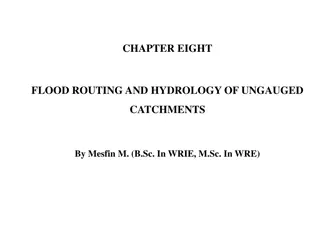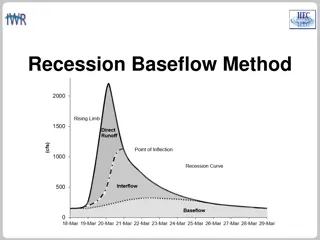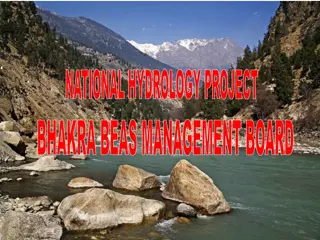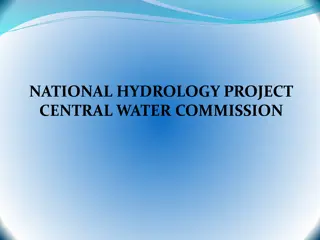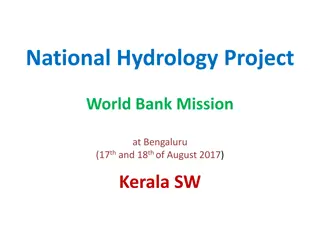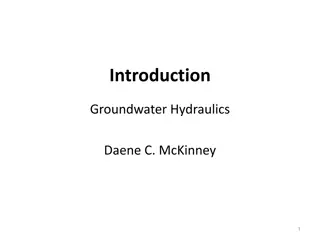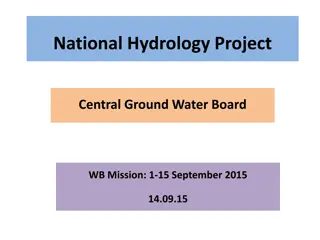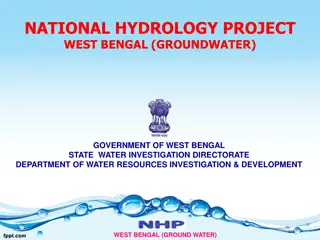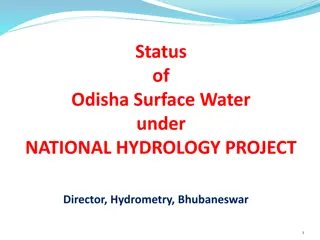Understanding Hydrology: The Science and Importance of Water
Hydrology is the science that studies the occurrence, circulation, and distribution of water on Earth, including its chemical properties and interaction with the environment. It involves estimating water resources, controlling floods and droughts, managing water use, and studying physical processes like evaporation and infiltration. The hydrological cycle, essential for sustainable agriculture and environmental protection, plays a crucial role in water resource management and disaster mitigation.
Download Presentation

Please find below an Image/Link to download the presentation.
The content on the website is provided AS IS for your information and personal use only. It may not be sold, licensed, or shared on other websites without obtaining consent from the author. Download presentation by click this link. If you encounter any issues during the download, it is possible that the publisher has removed the file from their server.
E N D
Presentation Transcript
Hydrology G205 course
Hydrology is the science that treats the waters of the earth, their occurrence, circulation and distribution, their chemical and physical properties, and their reaction with their environment, including their relation to living things. The domain of hydrology embraces the full life history of water on the earth
Estimation of water resource Hydrology deals with The study of processes such as precipitation, evapotranspiration, runoff and their interaction The study of problems such as floods and droughts and strategies to combat them
Water use water withdrawal and in stream uses What hydrologist do Water control flood and drought mitigation Pollution control point and nonpoint sources
Atmospheric process: cloud condensation and precipitation Surface process snow accumulation, overland flow, river flow, lake storage Hydrology study the following physical processes Subsurface processes Infiltration, soil water storage, groundwater flow Interfacial processes evaporation, transpiration, sediment-water exchange
Hydrological Cycle Hydrological cycle is the cyclic movement of water containing basic continuous processes like evaporation, precipitation and runoff. It is a continuous cycle which starts with evaporation from the water bodies such as oceans.
Study of hydrological cycle is essential for sustainable agriculture (foods for the growing population) environmental protection and management water resources development and management prevention and control of natural disasters mitigation of the negative impacts of climatic change
Study of hydrological cycle is essential for sustainable agriculture (foods for the growing population) environmental protection and management water resources development and management prevention and control of natural disasters mitigation of the negative impacts of climatic change
Components of hydrological cycle Evaporation it is the conversion of natural liquids like water into gaseous form like air. Condensation It is the conversion of a vapor or gas to a liquid Precipitation It is the fall of moisture from atmosphere to the earth s surface in any form. Example: rain, hail, snow, sleet, glaze, drizzle, snow flakes Transpiration it is the evaporation taking place from any plant or greenery. Example, water droplet on a leaf getting evaporated into atmosphere
Evapotranspiration it is the combination of evaporation and transpiration Infiltration it is the process of filtration of water to the inner layers of soil based on its structure and nature. Infiltration in soils like sand, gravel and coarser material is more and for finer soil particles like clay and silt, infiltration is less. Runoff it is the water flowing over the land making its way towards rivers, lakes, oceans etc. as surface or subsurface flow Surface runoff: it is the running water over the land and which ultimately discharge water to the sea Subsurface runoff: The water getting infiltrated into pervious soil mass, making its way towards rivers and lakes can be termed as subsurface run off
Depression storage it is the part of precipitation required to fill depression zones of land Interception Part of precipitation required to wet the surface of soil, buildings and all pervious surfaces
Process of Hydrological Cycle Process of hydrological cycle starts with oceans. Water in oceans, gets evaporated due to heat energy provided by solar radiation and forms water vapor. This water vapor moves upwards to higher altitudes forming clouds. Most of the clouds condense and precipitate in any form like rain, hail, snow, sleet. And a part of clouds is driven to land by winds. Precipitation, while falling to the ground, some part of it evaporates back to atmosphere. Portion of water that reaches the ground, enters the earth s surface infiltrating various strata of soil and enhancing the moisture content as well as water table. Vegetation sends a portion of water from earth s surface back to atmosphere through the process of transpiration. Once water percolates and infiltrates the earth s surface, runoff is formed over the land, flowing through the contours of land heading towards river and lakes and finally joins into oceans after many years. Some amount of water is retained as depression storage.
Watershed, Drainage Basin, and Catchment area An area of land that catches rain and other types of precipitation and then directs it to neighboring bodies of water
Watershed divide a line dividing land whose drainage flows toward the given stream from land whose drainage flows away from that stream.
Water balance equation for a catchment area In hydrology, a water balance equation can be used to describe the flow of water in and out of a system. The hydrological equation is simply the statement of the low of conservation of matter and it given by: ? ? = ? CHANGE OF STORAGE INPUT OUTPUT This equation states that during a given period, the total inflow into a given area must equal the total outflow from the area plus the change in storage.
Water balance equation for a catchment area Expression for the water budget of a catchment for a time interval t is written as P R G E T = S Change of storage Precipitation Transpiration Evaporation Surface runoff All terms in the equation have the dimensions of volume. Groundwater outflow All these terms can be expressed as depth over the catchment area (cm for example).
Solved example A lake had a water surface elevation of 103.200 m above datum at the beginning of a certain month. In that month the lake received an average inflow of 6.0 m3/s from surface runoff sources. In the same period the outflow from the lake had an average value of 6.5 m3/s. further, in that month, the lake received a rainfall of 145 mm and the evaporation from the lake surface was estimated as 6.10 cm. write the water budget equation for the lake and calculate the surface elevation of the lake at the end of the month. The average lake surface area can be taken as 5000 ha. Assume that there is no contribution to or from the groundwater storage.
Solved example P = 145 mm E = 6.10 cm Qout = 6.5 m3/s Qin = 6 m3/s Lake area = 5 000 ha 103.2 m datum
Solved example In a time period t the water budget for the lake can be written as Input volume output volume = change in storage precipitation evaporation Change in lake storage volume Average inflow rate Average outflow rate Surface area of the lake
Water budget equation SOLUTION Here t = 1 month How to convert to sec. It is a simple task, lets have a look = 2.592 106 s = 2.592 Ms
Solved example Inflow volume = = 6.0 2.592 = 15.552 Mm3 Outflow volume = = 6.5 2.592 = 16.848 Mm3 Input due to precipitation = P A = 7.25 Mm3 Convert ha to m2 (1 hectare = 10000 square meter) Convert mm to m (1 millimeter = 0.001 meter)
Solved example Outflow due to evaporation = EA = 3.05 Mm3 Hence S = 15.552 + 7.25 16.848 3.05 = 20.904 Mm3 Change in elevation z = s/A = 0.058 Net water surface elevation at the end of the month = 103.200 + 0.058 = 103.258 m
Residence Times The average time a water molecule will spend in that reservoir and it is a measure of the average age of the water in that reservoir




